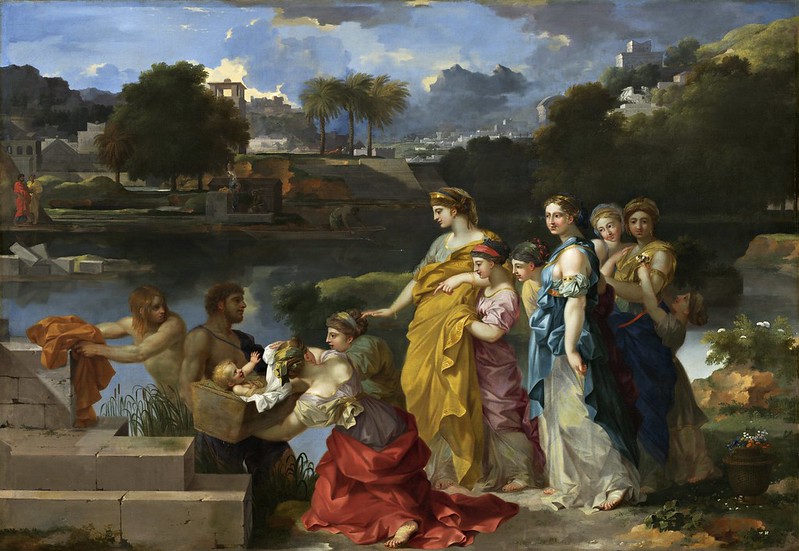Obra de Sébastien Bourdon (1616-1671), pintor francès (1)
- Recordatori de Gregorio Allegri -
En el dia de la commemoració del seu 364è aniversari de decés
Parlem de Pintura...
Sébastien Bourdon (Montpellier, 2 de febrer de 1616 - Paris, 8 de maig de 1671) va ser un pintor francès. Fill d'un pintor local, la seva família el va enviar a París als 7 anys, degut a la probable guerra que planava sobre la seva ciutat natal, de majoria protestant i en rebel·lió davant del Govern Reial el 1622. Durant set anys va treballar al taller d'un pintor parisenc de cognom Barthélémy. Després de viatjar per diverses ciutats franceses, el 1636 es va instal·lar a Roma, on hi va romandre fins a finals del 1637. Inicialment va pintar escenes quotidianes, molt de moda en el seu temps. No obstant i progressivament, la influència de Poussin es va anar imposant en la seva obra, motiu pel qual es va decantar pel classicisme del mestre francès qui per la seva part i instal·lat a Roma, va contribuir a renovar la pintura del seu país. El 1638 es va establir a París, on va fundar un taller de gran èxit i on va rebre nombrosos encàrrecs. Deu anys després va ser un dels membres fundadors de la Reial Acadèmia de Pintura i Escultura. Entre els anys 1652 i 1653 va viatjar a Suècia com a pintor de la reina Cristina de Suècia. De retorn a París, el seu estatus va ser més alt i els seus treballs molt sol·licitats, arribant a ser nomenat, el 1655, un dels quatre rectors de l'Acadèmia de Pintura. La seva mort, esdevinguda el maig de 1671 a París, el va consolidar com un dels més respectats i admirats pintors francesos del seu temps.
Font: En català: Sébastien Bourdon (1616-1671) - En castellano: Sébastien Bourdon (1616-1671) - In english: Sébastien Bourdon (1616-1671) - Altres: Sébastien Bourdon (1616-1671)
Parlem de Música...
Gregorio Allegri (Roma, 1582 - Roma, 17 de febrer de 1652) va ser un cantant i compositor italià. Germà de Domenico Allegri, va ser cantant de cor infantil des del 1591 i fins el 1596 i posteriorment tenor a San Luigi dei Francesi de Roma, sota les ordres del mestre de capella G.B. Nanino i amb qui es creu que es va formar. Segons el seu obituari, Allegri va ser actiu com a cantant i compositor de la Cattedrale di Santa Maria Assunta in Cielo de Fermo (1607-1621) i a partir de l'agost de 1628 com a mestre de capella de Santo Spirito in Sassia de Roma. El 1629 es va unir al cor papal, sota el Papa Urbà VIII, i va ser nomenat mestre de capella del Vaticà per l'any del jubileu (1650). Va ser hereu, musicalment, de la tradició del stile antico de Palestrina de qui en va revisar els himnes. Va morir a Roma el febrer de 1652.
OBRA:
Vocal religiosa:
Concertini, 2–5vv, bc, libro I (Rome, 1618), lost
Concertini, 2–5vv, bc, libro II (Rome, 1619)
Motecta, 2–6vv (Rome, 1621)
Sinfonia, a 4, ed. A. Kircher, Musurgia universalis (Rome, 1650)
Il salmo Miserere mei Deus, 9vv, I-Rvat; ed. in Amann and in Keyte
Missa ‘Che fa oggi il mio sole’, 5vv;
Missa ‘Christus resurgens’, 8vv;
Missa ‘In lectulo meo’, 8vv;
Missa ‘Salvatorem exspectamus’, 6vv;
Missa ‘Vidi turbam magnam’, 6vv: Rvat
2 Lamentationes Jeremiae prophetae, c1640, c1651, D-Bsb
Te Deum, 8vv, A-Wn
Laudate regem, 8vv, I-Rvat
Motets in 1618, 1619, 1621, 1623, 1625, 1626, 1626, 1639
OBRA:
Vocal religiosa:
Concertini, 2–5vv, bc, libro I (Rome, 1618), lost
Concertini, 2–5vv, bc, libro II (Rome, 1619)
Motecta, 2–6vv (Rome, 1621)
Sinfonia, a 4, ed. A. Kircher, Musurgia universalis (Rome, 1650)
Il salmo Miserere mei Deus, 9vv, I-Rvat; ed. in Amann and in Keyte
Missa ‘Che fa oggi il mio sole’, 5vv;
Missa ‘Christus resurgens’, 8vv;
Missa ‘In lectulo meo’, 8vv;
Missa ‘Salvatorem exspectamus’, 6vv;
Missa ‘Vidi turbam magnam’, 6vv: Rvat
2 Lamentationes Jeremiae prophetae, c1640, c1651, D-Bsb
Te Deum, 8vv, A-Wn
Laudate regem, 8vv, I-Rvat
Motets in 1618, 1619, 1621, 1623, 1625, 1626, 1626, 1639
Parlem en veu pròpia o en veu d'altri...
Allegri’s best music is in the a cappella style, much of it for two choirs: it was copied and recopied into Cappella Sistina manuscripts for at least a century. A fine example is the six-part Missa ‘Vidi turbam magnam’; based on his own motet it shows that the stile antico, far from being insipid, could be the vehicle for superbly controlled sonority and counterpoint, using syncopation to lead to a climax and with a bass line entirely harmonic in function. Along with other Roman composers, Allegri responded to the new vogue for small-scale concertato church music and his published pieces are mostly in a more modern idiom. Clearly these were not written for the papal choir but for smaller musical establishments in Rome such as Spirito in Sassia, or for a provincial centre such as Fermo, where Allegri was living when they were published. The first book of Concertini has not survived, but the second (dedicated to Duke Giovanni Antonio Altaemps) is written in an unambitious post-Viadana idiom, neither melodious in the manner of the best north Italians nor ornamented. Some pieces include dance-like triple-time sections, but contrapuntal considerations still predominate. The five-part Dilectus meus is very like a late 16th-century madrigal in style, with delicate textural and rhythmic contrasts.
GROVE MUSIC ONLINE (source/font: aquí)
Gaudiu i compartiu!
Informació addicional...
TACTUS: ALLEGRI, G. - Collectio Altæmps
IMSLP: Gregorio Allegri (1582-1652)
SPOTIFY: ALLEGRI, G. - Collectio Altæmps

Tant si us ha agradat, com si no, opineu, és lliure i fàcil!

Tant si us ha agradat, com si no, opineu, és lliure i fàcil!

Un administrador del blog ha eliminat aquest comentari.
ResponEliminaThanks a lot!
ResponEliminaBarbara
Gracias, muy interesante música!
ResponEliminaSaludos, Daniel, desde Madrid...
Obrigado, Pau!
ResponElimina